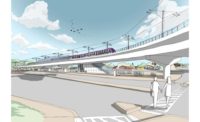In the desert just outside Santa Teresa, N.M., a 12-mile-long, $400-million railroad service and intermodal facility is nearing the end of construction. The Strauss Rail Yard is the first new yard to be developed by Union Pacific Railroad in nearly a century, and it is big.
"There really is nothing to compare it to. This has been a real renaissance," says Zoe Richmond, director of public affairs for Union Pacific's Phoenix office. "Trains have gotten a lot more efficient, but they are also a lot longer."
Driven by an inability to expand its landlocked operation in El Paso, Texas, Union Pacific has carved out a city from the desert approximately 20 miles northwest of El Paso.
"Building a facility like this is really like building a small city where there wasn't a city before," says Mike Zucker, civil engineer and terminal-design project manager with Union Pacific.
Construction occurred in two phases. The first began in 2011 and involved excavation and the relocation of a 345-kV power line, roads and other infrastructure. Construction on the second phase began in July 2012 and included mechanical, electrical, architectural, utilities, track and civil engineering portions of the project.
Union Pacific and its internal construction team, led by Dan King, performed most of the track construction, while traditional vertical buildings were done by outside specialists.
"We have to perform much of the work in-house because there are certain tasks at our facilities that take a specific expertise," Richmond says.
Wilson & Co., Albuquerque, is the designer of the facility and primary constructing consultant to Union Pacific. Nearly 100 other subcontractors have performed substantial work on the project.
Dave Olson, associate vice president of Wilson & Co., says that despite the project's large scale, relationships between Union Pacific and contractors on Strauss Yard follow the dynamic found on most rail projects. Construction management is supervised by Union Pacific with support from Wilson & Co. and Irvine, Calif.-based RailPros Inc.
"This is a 12-mile-long project, so there is a lot of rail and a lot of material on site," Olson says. "UP's full-time construction manager on site is complemented by construction management who go out and do inspections and observations and make sure that things are being constructed according to the plans and specifications."
A Mass-Grade Scenario
The carving operation during Phase 1 was massive. Nearly 5.8 million cu yd of soil have been scraped from the development area since construction began. Zucker says all of the dirt remained on the site and was redistributed in an effort to create the flattest surface possible for the flat-track facility. In rail applications, "flat" is defined as no more than a 0.3% grade.
"We had the challenge to make sure it was level," Zucker says. "The west end had more cut and the east side more fill, but we balanced it all out. It was a mass-grade scenario."







Post a comment to this article
Report Abusive Comment